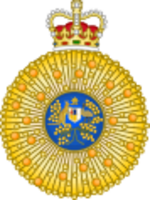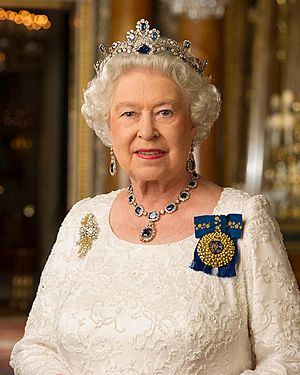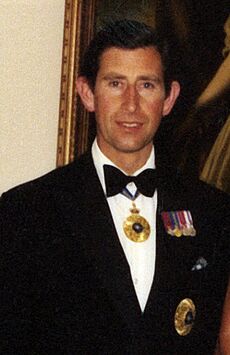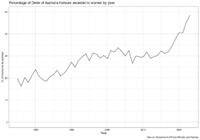Order of Australia facts for kids
Quick facts for kids Order of Australia |
|
|---|---|

Insignia of knights and dames of the Order of Australia
|
|
| Awarded by the governor-general of Australia |
|
| Type | National order |
| Awarded for | Achievement and merit in service to Australia or humanity |
| Founder | Elizabeth II, Queen of Australia on the advice of Gough Whitlam |
| Sovereign Head | Charles III, King of Australia |
| Chancellor and Principal Companion | Samantha Mostyn, Governor-General |
| Grades |
|
| Former grades | Knight/Dame (AK/AD) |
| Statistics | |
| First induction | 14 April 1975 |
| Total inductees | Total as of July 2024[update]
|
Ribbons: general division; military division |
|
The Order of Australia is a special award given to people in Australia. It celebrates Australians and others who have done amazing things and helped their country or the world. Queen Elizabeth II started this award on February 14, 1975. She did this with advice from the Prime Minister at the time, Gough Whitlam. Before this award existed, Australians could receive British awards. These British awards continued to be given out alongside the Order of Australia until 1992.
The Governor-General gives out these awards. They do this with the King's approval. The awards are based on suggestions from a group called the Council for the Order of Australia. Government members usually don't get involved in choosing who gets an award, except for military or honorary awards.
The King of Australia is the main leader of the Order. The Governor-General is the main companion and leader. The person who helps the Governor-General, currently Gerard Martin, is the secretary of the Order.
Levels of the Order
The Order of Australia has different levels of awards. These awards are given in two main groups: a general group and a military group. There are five levels, from the highest to the lowest:
- Knight and Dame of the Order of Australia (AK and AD) – These are no longer given out.
- Companion of the Order of Australia (AC)
- Officer of the Order of Australia (AO)
- Member of the Order of Australia (AM)
- Medal of the Order of Australia (OAM)
People who are not Australian citizens can also receive honorary awards at any level. These special awards are given in addition to the usual number of awards.
What the Awards Look Like
The look of the Order of Australia awards was designed by Stuart Devlin.
The Badge
The badge is a round, slightly curved disc. For the highest levels (AK, AD, and AC), it's made of gold. For the other levels (AO, AM, and OAM), it's gold-plated. The badge shows a single flower of the mimosa plant, which is an Australian wattle. In the middle, there's a ring that looks like the sea. Below it, the word "Australia" is written, with two mimosa branches. The whole badge has the Crown of St Edward on top.
- The AC badge has small yellow gems (citrines), a blue ring, and a blue crown.
- The AO badge is similar but doesn't have the gems.
- For the AM badge, only the crown is blue.
- The OAM badge is plain.
- The AK/AD badge is like the AC badge, but it has the coat of arms of Australia in the center.
The colors, royal blue and gold, come from Australia's national colors.
The Star and Ribbons
Knights and Dames also receive a special star. It's a curved gold disc with yellow gems. It has a blue, crowned disc in the center showing the Australian coat of arms.
The ribbon for the award is royal blue with a stripe of mimosa blossoms in the middle. For military awards, the ribbon has thin gold lines on the edges. Men wear their badges on a ribbon around their neck for AK, AC, and AO levels. For AM and OAM levels, they wear it on a ribbon pinned to their left chest. Women usually wear their badges on a bow on their left shoulder. However, they can choose to wear them the same way as men.
A small gold pin is also given with each badge. This pin can be worn every day. The AK/AD and AC pins have a gem in the center. The AO and AM pins have a blue center, and the OAM pins are plain.
How Awards Are Decided
The different levels of the Order are given based on how much a person has achieved.
| Award | What you need to do (General) | What you need to do (Military) | How many (per year) | |
|---|---|---|---|---|
| Knight/Dame (AK/AD) (No longer given) | "Amazing and top-level achievement and service to Australia or to all people." | Not given | 4 | 2014–15 |
| 2 | 1976–86 | |||
| Companion (AC) | "Excellent achievement and service of the highest level to Australia or to all people." | "Excellent service in very important jobs." | 35 | 2016 to present |
| 30 | 2003–16 | |||
| 25 | 1975–2003 | |||
| Officer (AO) | "Great service of a high level to Australia or to all people." | "Great service in important jobs." | 140 | 2016 to present |
| 125 | 2003–16 | |||
| 100 | 1975–2003 | |||
| Member (AM) | "Service in a specific area or to a specific group." | "Outstanding service or duty." | 605 | 2019 to present |
| 365 | 2018–19 | |||
| 340 | 2016–18 | |||
| 300 | 2003–16 | |||
| 225 | 1975–2003 | |||
| Medal (OAM) | "Service that deserves special recognition." | "Good service or duty." | No limit | |
How to Nominate Someone
Since 1976, any Australian citizen can suggest someone for an Order of Australia award. People who are not Australian citizens can also be nominated for honorary awards. You fill out a form and send it to the Honours Secretariat. This office is part of the Governor-General's team in Canberra.
The suggestions then go to the Council for the Order of Australia. This council has 19 members. Some are chosen by the Prime Minister, others by state and territory governments. The council decides who to recommend to the Governor-General.
Awards are announced on Australia Day (January 26) and on the King's Birthday public holiday in June. Sometimes, special announcements are made by the Governor-General. The Governor-General gives the awards to the new recipients.
An award can be given even if the person has passed away, as long as they were nominated while they were alive. People can also choose to give back their award. The Council can also suggest to the Governor-General that an award be taken away. All awards, cancellations, and resignations are announced publicly. The reasons for nominations being successful or not are kept private.
History of the Order
Early Ideas
Australia was once part of the British Empire. So, Australians could receive British awards for their achievements. But some people thought these awards were too old-fashioned. There were also concerns about how some awards were given out in the UK.
The Australian Labor Party wanted Australia to have its own awards. In 1949, a government group suggested creating an "Order of the Southern Cross" or "Order of the Golden Wattle." But the Labor government lost power before this could happen.
Starting the Order
The Order of Australia officially began on February 14, 1975. Queen Elizabeth II, as Queen of Australia, signed the documents. This happened because Prime Minister Gough Whitlam suggested it. The first Order had three levels: Companion (AC), Officer (AO), and Member (AM). It also had two groups: Civil and Military.
Whitlam had already said in 1972 that his government would stop suggesting people for British awards. When the awards were first shown, Whitlam was reportedly unhappy with the design. He didn't like that it included symbols of the states.
The Order of Australia was similar to the Order of Canada. However, Australia has given out more honorary awards to people who are not citizens. As of As of July 2024[update], 537 non-Australians have received an Order of Australia award.
People had mixed feelings about the new awards. Some thought it was great for Australia to have its own awards. Others thought they might not seem as important as the British ones. Some even made jokes about the name, calling them "Gough’s Gongs."
Changes Over Time
Ten months after the Order started, a new government led by Prime Minister Fraser took over. They decided to bring back British awards. But they also kept and expanded the Order of Australia. They added two new levels: Knight or Dame (AK or AD) and the Medal of the Order of Australia (OAM). The Civil Division was renamed the General Division. This allowed military people to receive awards for non-military achievements. These changes happened on May 24, 1976.
Later, in 1983, Prime Minister Bob Hawke stopped recommending British awards again. He also removed the Knight/Dame level in 1986. During the time it was active (1976-1983), twelve knights and two dames were created.
Knights and Dames Reintroduced and Removed Again
On March 19, 2014, Prime Minister Tony Abbott brought back the Knight or Dame level. The Queen agreed to this change. Up to four knights or dames could be appointed each year. The Prime Minister would suggest these names to the Queen.
Five people received these new Knight or Dame awards. They included the former and current Governor-Generals, a military chief, a state governor, and Prince Philip. The award to Prince Philip caused a lot of discussion and criticism. Many people in Australia were not happy about it.
The Labor Party continued to oppose knighthoods and damehoods. In September 2015, a new Prime Minister, Malcolm Turnbull, took office. Two months later, he announced that the Queen had agreed to remove the Knight/Dame level again. Existing titles were not affected. This decision was praised by those who wanted Australia to be a republic and criticized by those who supported the monarchy. The changes were made official on December 22, 2015.
Who Leads the Order Now
- Sovereign Head: The King of Australia (Charles III)
- Chancellor and Principal Companion: The Governor-General of Australia (Sam Mostyn)
- Secretary: The Official Secretary to the Governor-General of Australia (Gerard Martin)
King Charles III, when he was Prince of Wales, became a Knight of the Order of Australia (AK) in 1981. Since he was not an Australian citizen, this was a special honorary award. It required a change to the Order's rules.
In 2014, when the Knight and Dame levels were brought back, Prime Minister Tony Abbott said he would recommend future appointments at this level himself. This was different from how lower levels were decided. Prince Philip received a knighthood in 2015 based on Abbott's advice. This decision also caused debate. Abbott later said that future recommendations for Knights and Dames would go through the Council of the Order of Australia.
Honorary Awards
The Order of Australia sometimes gives awards to people who are not Australian citizens. This is to honor their amazing achievements. These people or their achievements are often connected to Australia, but not always. As of As of July 2024[update], 46 Honorary Companions, 118 Honorary Officers, 174 Honorary Members, and 199 Honorary Medals have been awarded.
Some famous people who have received honorary awards include:
- Honorary Companion: Many notable people have received this. You can find a list at List of Honorary Companions of the Order of Australia.
- Honorary Officer: Mel Gibson, Clive Lloyd, David Petraeus, and James Wolfensohn.
- Fred Hollows, who was from New Zealand, was offered an honorary award in 1985 but said no. He became an Australian citizen in 1989 and then received a full Companion award in 1991.
- Honorary Member: Brian Lara, Sachin Tendulkar, and Robyn Williams.
- Terri Irwin received an Honorary Member award in 2006. This became a full award when she became an Australian citizen in 2009.
Women in the Order
Since 1975, just over 30% of all Order of Australia awards have gone to women. The number of women being nominated and receiving awards is increasing. In the 2023 Australia Day Honours, nearly half (47.1%) of the awards went to women. Groups like Honour a Woman are working to achieve equal representation for men and women in the Order.
Total Awards Given
Here's a look at the total number of awards given as of As of July 2024[update]:
| All levels | Knight/Dame (AK/AD) | Companion (AC) | Officer (AO) | Member (AM) | Medal (OAM) | |
|---|---|---|---|---|---|---|
| Civil/General division | 44,484 | 19 | 580 | 3,198 | 11,635 | 29,052 |
| Military division | 3,101 | Not created | 26 | 296 | 1,360 | 1,419 |
| Honorary general division | 311 | 0 | 45 | 95 | 171 | |
| Honorary military division | 27 | Not created | 1 | 26 | 3 | |
| Total honorary awards | 537 | 0 | 47 | 121 | 174 | 199 |
| Total full awards | 47,332 | 19 | 606 | 3,494 | 12,995 | 30,471 |
| Total awards | 47,869 | 19 | 647 | 3,615 | 13,169 | 30,670 |
What Order Do Awards Go In?
The Australian government decides the official order for wearing Australian and other approved awards. This means there's a specific way to arrange them if someone has many different honors.
| Before | Level | After |
|---|---|---|
| Member of the Order of Merit (OM) | Knight/Dame | Knight/Dame Grand Cross of the Order of St Michael and St George (GCMG) |
| Knight/Dame Grand Cross of the Order of the British Empire (GBE) | Companion | Companion of Honour (CH) |
| Knight Bachelor | Officer | Companion of the Order of the Bath (CB) |
| Distinguished Service Cross (DSC) | Member | Lieutenant of the Royal Victorian Order (LVO) |
| Australian Intelligence Medal () | Medal | Order of St John |
Learn More
- Commonwealth realms orders and decorations
- Order of New Zealand
- Order of the British Empire
- Légion d'honneur
See also
 In Spanish: Orden de Australia para niños
In Spanish: Orden de Australia para niños





